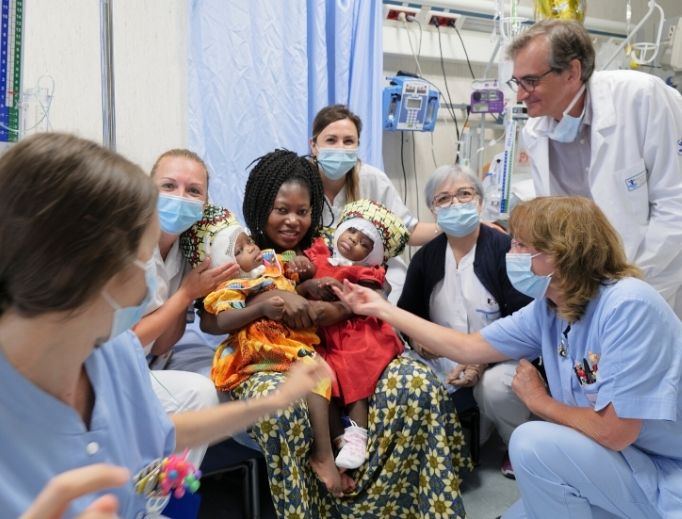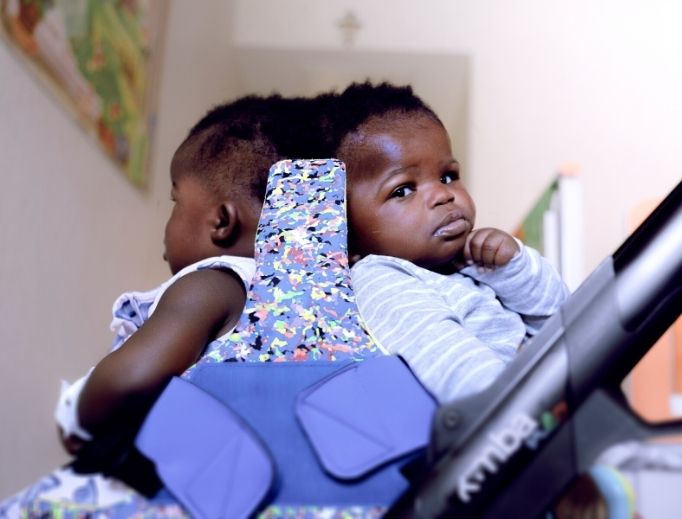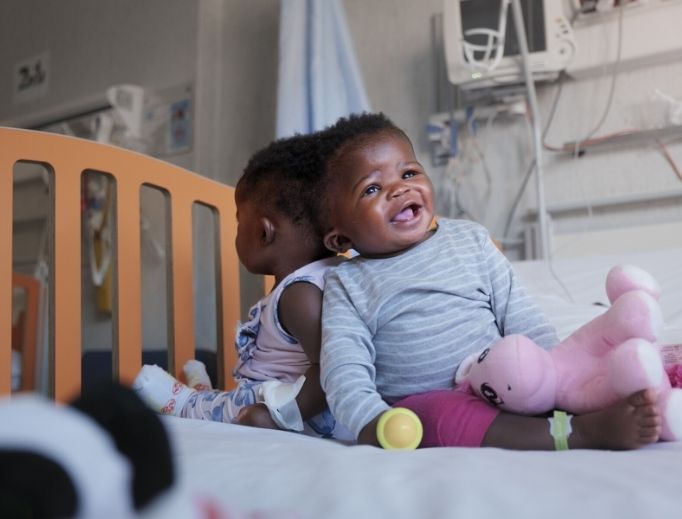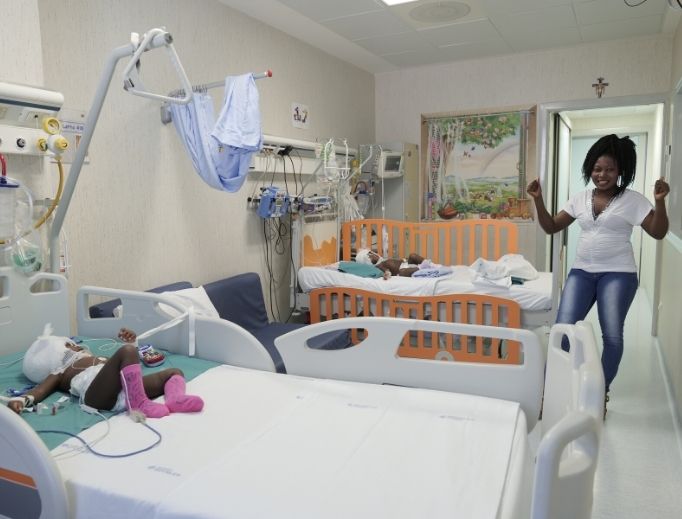Double Blessings: Separation of Conjoined Twins in Hospital Reaffirms Value of Life
The successful surgery on two girls conjoined at the back of the head was made possible thanks to the Bambino Gesù Hospital’s commitment in favor of the dignity of every human life.

VATICAN CITY — A climate of euphoria has settled upon “the Pope’s hospital,” since the successful surgical operation that enabled the separation of two Central African children conjoined at the skull.
Ervina and Prefina Bangalo had in common their cranial bones and skin, as well as a significant part of their venous system. They were positioned neck to neck. This extremely rare and complex case, which affects one in 2.5 million newborn children, required three different and very delicate interventions preceded by a long process of study that spread over the course of more than a year.
The separation was completed June 5. The twins, who turned 2 on June 29, are doing fine and are still hospitalized at the neurosurgery department of the Vatican hospital.
“When we told the twins’ mother that everything went well, she started dancing in the middle of the hospital — we were all in such a state of joy!” Mariella Enoc, president of Bambino Gesù Children’s Hospital, told the Register, adding that the greatest success of this operation was that both sisters could survive and that they are finally able to look at each other.
Such a successful operation on twins conjoined in this way is considered unprecedented, as no other similar case has been reported in the scientific literature so far.
“It is a world first, considering the very rare kind of cranial fusion, which was very extended and presented significant problems [notably the common cerebral venous system] often associated with a high mortality rate,” Dr. Carlo Efisio Marras, director of the neurosurgery department at the Bambino Gesù and head of the medical team that performed the surgeries, told the Register.

The surgical team’s protocol has gained the notice of the scientific community worldwide and will provide a model for other similar cases in the future.
Leaving Nothing to Chance
The first two phases of the process, respectively performed in May and June 2019, focused on the creation of two autonomous venous systems able to limit the load of blood that circulates from the brain to the heart.


A few months before the third step, during which the cranial bones that conjoined the girls were divided, a portion of their skin was extended through small expanders that were positioned during a series of plastic surgeries, in order to cover each skull afterwards.
The final operation lasted 18 hours, from 8am to 3am of the following day, involving a multidisciplinary team of 30 experts.
“There could have been serious consequences, as the perspective was very complex; but while studying the case all together with the medical group, using very sophisticated technologies, we could structure a very detailed protocol and reach our goal,” Marras said, adding that he personally prepared himself for an entire year before the separation of the twins, gathering as much information as he could, using both available neurosurgery knowledge and the significant material resources that the pediatric hospital put at his disposal.
Besides the unforgettable and moving moment when the two girls were successfully separated, the preparatory phase remains a highly significant part of the process for the whole medical team. It was particularly the case for Dr. Mario Zama, responsible for the maxillofacial and plastic surgery, who took care of all the aspects related to the bone and skin reconstruction.
For him, the planning phase was the most fascinating part because he and the rest of the team studied every possibility, in every detail. “We left absolutely nothing to chance,” he told the Register.
After the successful intervention, the medical team stayed on call for a few days in case any abnormality occurred. It will only be after a few weeks that they can savor the taste of victory for separating the twins.
But the extreme attention to details that characterized the team’s work was fueled by something deeper than mere passion for science. The interaction and the subsequent bond that they all individually created with the twins and their mother has had a decisive impact on the whole medical process, which became for each of them a personal mission.
“Everything that we’ve done was infused with a feeling of pleasure for doing something to help them, so our job was less difficult, and we were more motivated in our search for solutions,” Marras said, revealing that this personal relationship helped him keep his focus during this life-changing endeavor.

Fighting the ‘Throwaway’ Culture
“It is always the Lord that guides my mind and my hand. I just think about that when I operate,” Zama said. “It is him that gives me strength, concentration and helps me keep my nerves healthy while performing delicate surgeries like this one.”
As a Catholic, Zama is committed to put his talent at the service of the least of this world. He sees such a mission as the most meaningful part of his professional life and is involved in several projects of the Bambino Gesù Hospital in poor countries. Indeed, giving relief to the suffering children who don’t have access to sophisticated treatments is, in his view, a moral duty.
It is this very conception of the value of life that induced the hospital’s president, Mariella Enoc, to bring the newborn twins from Bangui to Rome in 2018. She was supervising the work of the pediatric institution funded by Pope Francis in the Central African capital when she became aware of their case. “I was not sure we would be able to save them, but I couldn’t not try,” she told the Register.
“I’ve been living this whole medical process with hope, but at the same time with a great sense of responsibility, as the president of this hospital, because we had to commit a lot of resources to it,” she said, noting that the 1-million-euro budget necessary for the twins’ care was also a risk for the hospital’s sustainability.
To this extent, she has been investing a lot of energy raising funds through the hospital’s foundation in order not to impose a too-heavy financial burden upon the functioning of the structure.
“I always say that we will do the accounts later. … If I were a good administrator, I would have had to give up many great projects that helped save children. So let’s say that I am an administrator of charity, who counts on people’s solidarity!”
The Bambino Gesù has also distinguished itself through other important projects in defense of life recently, notably through successful in utero operations and the purchase of machinery designed to analyze and quantify more quickly DNA mutations responsible for many childhood diseases.
“The hospital touches all relevant specialties for children, because our logic is that of the love of life against the ‘throwaway’ logic, to quote Pope Francis’ words,” Enoc said. “We believe that there is nothing to reject in a human life, and we want to embody that message.”
Solène Tadié is the Register’s Europe correspondent.
















